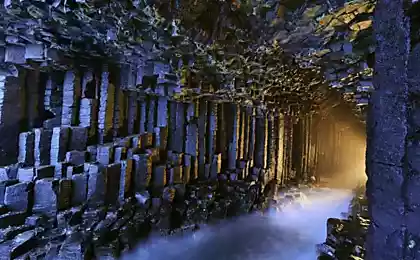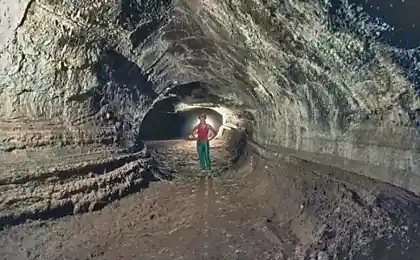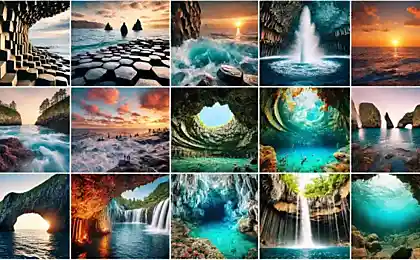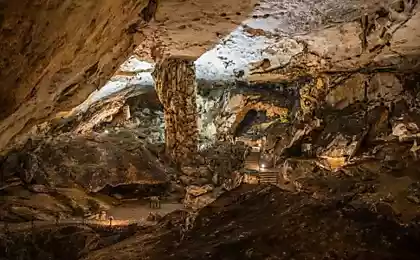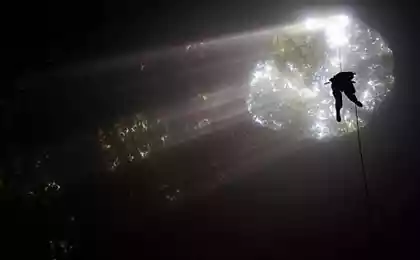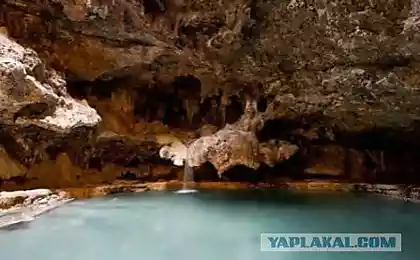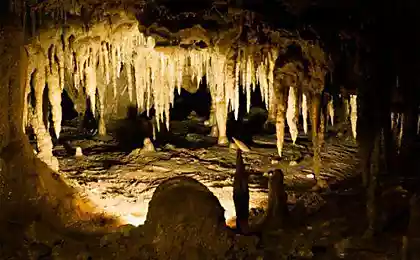1259
Postojna Cave
Dinaric mountains, stretching along the east coast of the Adriatic Sea - a classic area of karst caves and related natural phenomena: the surprise round, as if drawn with a compass, lakes and flops craters, bottomless vertical shafts, wells and mysterious rivers that suddenly disappear at some section of its valley, to reappear two or three kilometers downstream. The word "karst" means the totality of the processes occurring during dissolution of rocks came from the name of the limestone plateau in the Dinaric mountains. And on the west end of the Karst, near the picturesque mountain Sovich, where towering ruins of the ancient castle of the XIII century, is one of the largest and most beautiful caves in Europe - Postojna Jama. ("The Pit" in Slovenian - Cave.)

The castle on the hill, by the way, stood for four centuries, and would stand still, if in 1689 the lightning did not hit his tower was stored gunpowder. Fortress, soaring into the air, did not begin to recover, but instead built a new castle at the bottom, under the mountain, in the center of the small town of Postojna. Now the castle is located Slovenian Karst Research Institute. For objects of research scientists do not have to go far: after five hundred meters above on the hillside is the entrance to one of the longest and beautiful world of underground cavities.
Stretching nearly twenty kilometers a grand maze of halls, passages, slopes, tunnels and corridors was opened and investigated by scientists in the middle of the last century. Now the cave became a popular place, which tend to get travelers from all over Europe. Postojna is well equipped to receive tourists. Narrow Gauge Railroad length of seven kilometers allows visitors to look into the remotest corners of the underworld, without overcoming the difficulties faced by the first explorers of the cave. It is only necessary to stock up on warm clothes (because the temperature in the halls of Postojna in winter and summer - eight degrees Celsius), as well as throw raincoat to hide from the underground dripping.
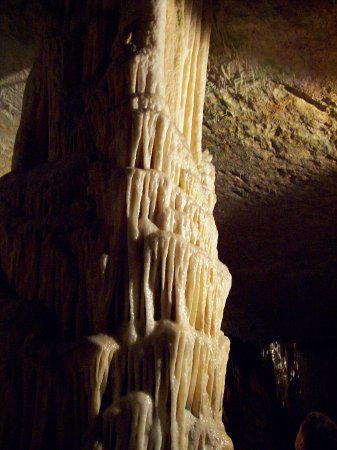
Many of stone masterpieces can be seen in the underground halls. Among them are a large stalagmite Cypress, really like a slender tree, sculptured by nature of Tom Thumb, peeking out from behind the stone columns, delicate stalactite draperies, woven from the finest filamentary sag. Illuminated from within, she poured all sorts of shades of red, from pink to scarlet.
The walls of the rooms seem to be cast from metal, then made of ivory, faded from the dust covering it. Huge columns of the most intricate shapes prop arches decorated with multi-ton stone "icicles." Sometimes a palisade columns fills the space of the hall, and train rides like a stone in the forest.
In some places the ceiling, bringing dissolved therein lime, water drips. From the floor of the cave stalagmites rise. Many thousands of years they will need to meet with stalactites hanging from above: because they grow very slowly - one millimeter for a hundred years!
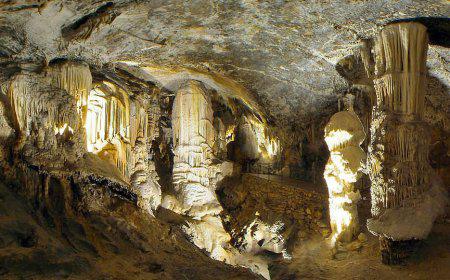
But narrow-gauge railway plunges into a dark tunnel and out of it already on the edge of a steep cliff. In a deep ravine under his feet noise stormy river Pivka. Not far away, it leaves the surface of the ground, and running through the cave nine kilometers away, coming to light under the name Unica.
In an underground lake train makes a stop. Here you can see the unique amphibians living only in RSD caves - Proteus. Proteus lifetime conducts underground in the dark and thus deprived of. Blind cave as spiders and scorpions, and even fish that live in underground lakes.
Travelers who want to see more, can leave the train and go on foot along a concrete path, fenced railing. It rises steeply at first sorokapyatimetrovy boulder pile Big Mountain. (In this country there are underground and their mountain!) Around ten-sinter towering columns, and between them rises from the floor young stalagmite growth, growing up a stone like a grass. Then, on the Russian bridge over tridtsatimetrovoy cleft, the path leads to the fantastic traveler rooms Beautiful Pit. From her gentle serpentine path down to pyatisotmetrovomu artificial tunnel connecting Postojna caves black and beer. After going on a long balcony, carved into the rock along a babbling creek beer on the rocks, the tourist is at the bottom of the majestic nature of the mine-pit of failure Piva. From forty-meter ascent on a paved path prints, finally, on the surface, five kilometers from the entrance to the cave.

Most striking in Postojna Yam gigantic dimensions rooms and galleries. For example, the Great Hall, adapted for concerts, can accommodate up to ten thousand people! And its excellent acoustics. Even a small chamber orchestra sounds here with the power of unprecedented authority.
It is difficult to compare the Slovenian cave with Russian or Ukrainian underground cavities. The famous Kizil-Koba - Red Cave in the Crimea with all its mnogosotmetrovymi galleries, caves and waterfalls could fit in one or two rooms Postojna pit. There are no words, many of our caves in the Urals, Siberia and the Caucasus are not inferior to her beauty. But their sizes are incomparable.

In Europe, the underground wonder of Slovenia can be compared to that recently opened (in 1971) in the Italian system of caves Frasassi. Its main cave - Grotta Grande del Vento ("Great Cave of the Winds"), which stretches for 13 kilometers, no less impressive Postojna, especially unique Sala delle Candelin ("Hall of Candles"), which hang from the ceiling stalactites thousands cream. Unusual, a little eerie impression is located next door to the Cave of the Winds Grotta delle Nottole ("bat cave"), where the vaults hanging upside down tens of thousands of these tiny nocturnal mammals. In the evening when the sun goes down, at the entrance to the cave begins a genuine pandemonium. Continuous flow flied out to night hunting of black throat underground cavity bats, and within an hour or even longer heard in the air shrill popiskivanie and the rustle of thousands of wings. However, the underground palaces of the Apennine Mountains is still not as well equipped to receive tourists.
In Slovenia, Postojna Jama - is not the only gem of karst. Not far away there is another wonder of nature - an ambitious mine-Ponor Shkotsian. Ponor (well, washed with water soluble rocks) is so great that the inclined walls of the sinkhole was able to build a spiral highway leading to its bottom. Hence by the sloping tunnel stotridtsatimetrovomu can get to the first system of halls, decorated grand hall which is Paradise. But the main highlight Shkotsiana - Mullerian room. At its center, enclosed concrete parapet devyanostometrovaya gaping chasm, the bottom of which roars and rages underground stream: Notranska river. Disappearing below ground near Shkotsiana this stream passes under the ground 20 kilometers and comes to light at the very coast of the Adriatic Sea as a powerful source of Timavo.
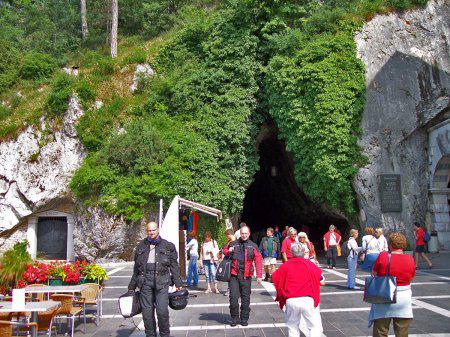
The steep walls of the subterranean abyss Shkotsiana arranged balcony, connected by a staircase, and the cave visitors can descend to the next level, fifty meters below the ground. There are also many beautiful halls and passageways, one of which ends at the underground lake of the Dead. Behind him begin unexplored rugged continue Shkotsiana, exploration of which is yet to come.
Crossing the chasm for Hankeevu bridge, dangling over the abyss, you can gradually go down to the river, walk past a large lake Haronova and reach the long and high hall - Schmiedlova Dvoranu. From it a tourist gets to the bottom of the Grand disastrous funnel, where it is not difficult to climb to the surface. In the world there is, perhaps, another place where no armed with special equipment the traveler can get by underground passages to dvuhsotmetrovuyu depth!

However, the most attractive cave in Slovenia is still Postojna Jama. Yielding Shkotsianu depth, it fascinates the viewer fabulous beauty and diversity of its rooms, its enormous size. It attracts tourists and the opportunity to make many kilometers of underground world trip in an open trailer NGR.
And going on a trip to the Adriatic coast, it is worth to pay attention not only to the beautiful island of the Dalmatian coast and the ancient walls of Dubrovnik and Split. The impression of this corner of southern Europe will not be complete if you do not see the jewel of the Dinaric Karst - Postojna cave.
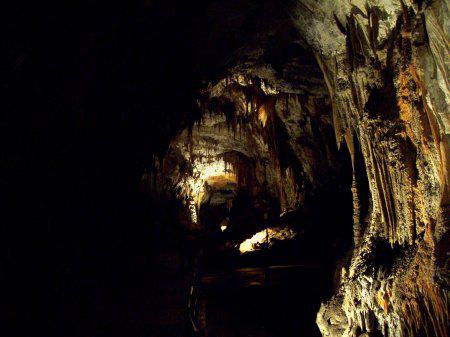

The castle on the hill, by the way, stood for four centuries, and would stand still, if in 1689 the lightning did not hit his tower was stored gunpowder. Fortress, soaring into the air, did not begin to recover, but instead built a new castle at the bottom, under the mountain, in the center of the small town of Postojna. Now the castle is located Slovenian Karst Research Institute. For objects of research scientists do not have to go far: after five hundred meters above on the hillside is the entrance to one of the longest and beautiful world of underground cavities.
Stretching nearly twenty kilometers a grand maze of halls, passages, slopes, tunnels and corridors was opened and investigated by scientists in the middle of the last century. Now the cave became a popular place, which tend to get travelers from all over Europe. Postojna is well equipped to receive tourists. Narrow Gauge Railroad length of seven kilometers allows visitors to look into the remotest corners of the underworld, without overcoming the difficulties faced by the first explorers of the cave. It is only necessary to stock up on warm clothes (because the temperature in the halls of Postojna in winter and summer - eight degrees Celsius), as well as throw raincoat to hide from the underground dripping.

Many of stone masterpieces can be seen in the underground halls. Among them are a large stalagmite Cypress, really like a slender tree, sculptured by nature of Tom Thumb, peeking out from behind the stone columns, delicate stalactite draperies, woven from the finest filamentary sag. Illuminated from within, she poured all sorts of shades of red, from pink to scarlet.
The walls of the rooms seem to be cast from metal, then made of ivory, faded from the dust covering it. Huge columns of the most intricate shapes prop arches decorated with multi-ton stone "icicles." Sometimes a palisade columns fills the space of the hall, and train rides like a stone in the forest.
In some places the ceiling, bringing dissolved therein lime, water drips. From the floor of the cave stalagmites rise. Many thousands of years they will need to meet with stalactites hanging from above: because they grow very slowly - one millimeter for a hundred years!

But narrow-gauge railway plunges into a dark tunnel and out of it already on the edge of a steep cliff. In a deep ravine under his feet noise stormy river Pivka. Not far away, it leaves the surface of the ground, and running through the cave nine kilometers away, coming to light under the name Unica.
In an underground lake train makes a stop. Here you can see the unique amphibians living only in RSD caves - Proteus. Proteus lifetime conducts underground in the dark and thus deprived of. Blind cave as spiders and scorpions, and even fish that live in underground lakes.
Travelers who want to see more, can leave the train and go on foot along a concrete path, fenced railing. It rises steeply at first sorokapyatimetrovy boulder pile Big Mountain. (In this country there are underground and their mountain!) Around ten-sinter towering columns, and between them rises from the floor young stalagmite growth, growing up a stone like a grass. Then, on the Russian bridge over tridtsatimetrovoy cleft, the path leads to the fantastic traveler rooms Beautiful Pit. From her gentle serpentine path down to pyatisotmetrovomu artificial tunnel connecting Postojna caves black and beer. After going on a long balcony, carved into the rock along a babbling creek beer on the rocks, the tourist is at the bottom of the majestic nature of the mine-pit of failure Piva. From forty-meter ascent on a paved path prints, finally, on the surface, five kilometers from the entrance to the cave.

Most striking in Postojna Yam gigantic dimensions rooms and galleries. For example, the Great Hall, adapted for concerts, can accommodate up to ten thousand people! And its excellent acoustics. Even a small chamber orchestra sounds here with the power of unprecedented authority.
It is difficult to compare the Slovenian cave with Russian or Ukrainian underground cavities. The famous Kizil-Koba - Red Cave in the Crimea with all its mnogosotmetrovymi galleries, caves and waterfalls could fit in one or two rooms Postojna pit. There are no words, many of our caves in the Urals, Siberia and the Caucasus are not inferior to her beauty. But their sizes are incomparable.

In Europe, the underground wonder of Slovenia can be compared to that recently opened (in 1971) in the Italian system of caves Frasassi. Its main cave - Grotta Grande del Vento ("Great Cave of the Winds"), which stretches for 13 kilometers, no less impressive Postojna, especially unique Sala delle Candelin ("Hall of Candles"), which hang from the ceiling stalactites thousands cream. Unusual, a little eerie impression is located next door to the Cave of the Winds Grotta delle Nottole ("bat cave"), where the vaults hanging upside down tens of thousands of these tiny nocturnal mammals. In the evening when the sun goes down, at the entrance to the cave begins a genuine pandemonium. Continuous flow flied out to night hunting of black throat underground cavity bats, and within an hour or even longer heard in the air shrill popiskivanie and the rustle of thousands of wings. However, the underground palaces of the Apennine Mountains is still not as well equipped to receive tourists.
In Slovenia, Postojna Jama - is not the only gem of karst. Not far away there is another wonder of nature - an ambitious mine-Ponor Shkotsian. Ponor (well, washed with water soluble rocks) is so great that the inclined walls of the sinkhole was able to build a spiral highway leading to its bottom. Hence by the sloping tunnel stotridtsatimetrovomu can get to the first system of halls, decorated grand hall which is Paradise. But the main highlight Shkotsiana - Mullerian room. At its center, enclosed concrete parapet devyanostometrovaya gaping chasm, the bottom of which roars and rages underground stream: Notranska river. Disappearing below ground near Shkotsiana this stream passes under the ground 20 kilometers and comes to light at the very coast of the Adriatic Sea as a powerful source of Timavo.

The steep walls of the subterranean abyss Shkotsiana arranged balcony, connected by a staircase, and the cave visitors can descend to the next level, fifty meters below the ground. There are also many beautiful halls and passageways, one of which ends at the underground lake of the Dead. Behind him begin unexplored rugged continue Shkotsiana, exploration of which is yet to come.
Crossing the chasm for Hankeevu bridge, dangling over the abyss, you can gradually go down to the river, walk past a large lake Haronova and reach the long and high hall - Schmiedlova Dvoranu. From it a tourist gets to the bottom of the Grand disastrous funnel, where it is not difficult to climb to the surface. In the world there is, perhaps, another place where no armed with special equipment the traveler can get by underground passages to dvuhsotmetrovuyu depth!

However, the most attractive cave in Slovenia is still Postojna Jama. Yielding Shkotsianu depth, it fascinates the viewer fabulous beauty and diversity of its rooms, its enormous size. It attracts tourists and the opportunity to make many kilometers of underground world trip in an open trailer NGR.
And going on a trip to the Adriatic coast, it is worth to pay attention not only to the beautiful island of the Dalmatian coast and the ancient walls of Dubrovnik and Split. The impression of this corner of southern Europe will not be complete if you do not see the jewel of the Dinaric Karst - Postojna cave.






